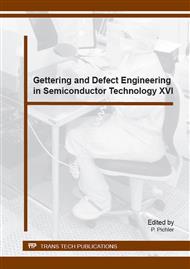p.427
p.434
p.440
p.449
p.459
p.466
p.472
p.478
p.484
Capacitance Transient Spectroscopy Measurements on High-k Metal Gate Field Effect Transistors Fabricated Using 28nm Technology Node
Abstract:
Fast progress in nanometer-node high-k metal gate (HKMG) technology requires the development of versatile and detailed characterization methods for semiconductor / dielectric / metal stacks and interfaces between them. Complexity of the advanced fabrication processes does not allow preparation of model samples with dimensions used in standard laboratory measurements. In this report we apply capacitance transient spectroscopy measurements for the characterization of HKMG field effect transistors (FET) fabricated in the standard 28 nm node technology. Measurements were performed on n-FET devices. The devices were characterized in the as-fabricated stage, after application of electrical stress and after fluorine implantation introduced to passivate the interface carrier traps. Our results show good correspondence with those obtained by other characterization methods and supply detailed information on the energy distribution of the interface trap density in the system.
Info:
Periodical:
Pages:
459-465
Citation:
Online since:
October 2015
Authors:
Price:
Сopyright:
© 2016 Trans Tech Publications Ltd. All Rights Reserved
Share:
Citation:


